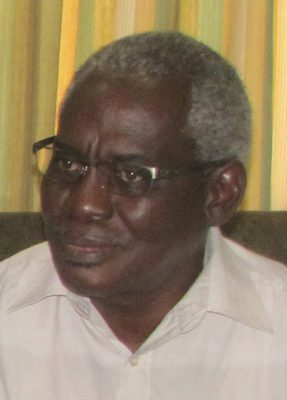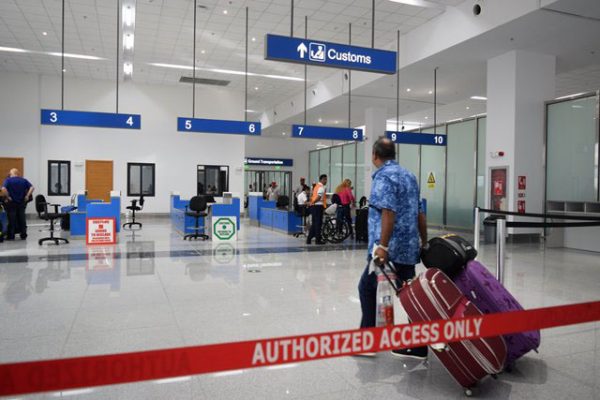Minister of Public Infrastructure David Patterson has welcomed a call by former Minister of Public Works Robeson Benn for an investigation into the Cheddi Jagan airport expansion project.
In a letter in yesterday’s Stabroek News, Benn had called for a full-fledged probe of the altering of the contract for the expansion of the Cheddi Jagan Inter-national Airport (CJIA). Benn was res-ponding to Facebook posts by Patterson, who was critical of the project’s handling under the former PPP/C government.
On April 22, on his Facebook page, Patterson had made a post intended “to address an issue that has been circulating for a couple of weeks – the matter of sand filling to the CJIA project.”

Patterson observed that the Kaieteur News has been carrying “this erroneous story for some time” and he has noticed that “comrades from the PPP have picked up on this topic in one of their eureka moments.”
He highlighted that the contract for the extension of the CJIA was signed on November 11, 2011 between China Harbour Engineering Company (CHEC) and the Ministry of Public Works and Communications and, at the time of the signing of the contract, no feasibility studies or soil investigations were done and there were also no site surveys, detailed studies or preliminary reports prepared but a contract sum and general scope of works were nonetheless, agreed.
“Actual construction works did not commence on site until January 16, 2013 – 15 months after the signing of the contract. Note that the Supervising Consultants (MMM Group Limited in association with CEMCO) did not commence their supervision until July 1, 2014, which meant that CHEC worked for over 18 months without independent supervision. The contract signed by the then Government allowed for the provision of sand free of cost to the contractor, within a 12km radius of the project plus it committed the GoG to pay US$3.115 per cubic metre for the ‘exploit and transportation of sand’,” Patterson wrote.
He added that soon after commencement of the works in 2013, the soil conditions in the proposed northeast runway were found to be unsuitable – something that could have been discovered if studies were executed before the signing of the contract – and the decision to also extend the runway in the southwest direction was taken by the then PPP government which resulted in additional excavation and sand-filling.
Patterson further explained that in 2015, the new APNU+AFC government was presented with a project that was “badly performing” as almost 35 per cent of the monies were already expended and the contract had claims for over US$44 million, and if successful, the government would have paid US$90 million for less than seven per cent of the actual work.
Abandon the project
An assessment of the project was done in 2015 and he said the government was presented with the following options: abandon the project completely, which carried the risk of losing all the monies paid to the contractor as well as a possible court case; allocate additional funds to the project, estimated at approximately US$35 million to make up for the poor preliminary planning and execution; or complete the project within the allocated contract sum.
He said that Cabinet, after deliberations, opted for the last option, following strict

guidelines that: the contract sum remains at the same level; the runway be completed to international specifications; the terminal buildings must be able to adequately accommodate the projected passenger increase; and that no unnecessary residents of Timheri North be removed.
“Despite the accusations of (Kaieteur News), the decision to allow extra sand filling plus the cost payable for the sand was all taken by the PPP government – thus the volume of sand filling required moved from 4.4M cubic metres to 10.1M cubic metres – this is due to the fact that the South West section is at a lower elevation than the North East. The cost per cubic metre was also determined by my predecessor,” Patterson added.
Patterson’s post prompted Benn’s letter, in which he said that the project has been tremendously modified and it needs to be investigated. “…the scope of this project seems to have been tremendously modified with the effect of impairing the project’s original intended validity and integrity,” he wrote.
Patterson responded to Benn’s letter yesterday morning via his Facebook page. He said that Benn’s call for an investigation “is most welcome.”
Enlightened
“In fact, the reason we are having this open debate on this project is based on my belief that public procurement is exactly that – public. Gone are the days when the cry for ‘an investigation’ sends shivers down the backs of public officials – we are in a more enlightened and informed age,” he said.
Patterson added that while he has zero interest in debating with Benn, he is compelled to highlight a few glaring points of concern raised in the former minister’s letter.
As it relates to the assertion by Benn that the Works Services Group (WSG) of the Ministry of Public Works was in charge of supervision until a consultant was hired, Patterson said, “This is an incredible statement coming from a former Minister of Works in response to the lack of independent supervision on a Design and Build Contract for more than three years after the contract signing. In my over twenty-five years as a consultant in the construction industry, I have never heard of any Government or even private sector organization supervising a D&B contract in-house, the reason is simple – risk.”
“A Design and Build Contract means that the contractor designs the project, submits it to the client representatives, who reviews and approves these designs and then the contractor builds the project. In house supervision of a D&B contract is akin to a lawyer representing himself and as the old adage goes – ‘a lawyer who represents himself has a fool for a client’. In fact, in projects such as CJIA, the project consultants are retained long before the contractors are even engaged. This has been standard practice worldwide – a simple Google search will confirm these details,” Patterson said, while highlighting that Benn made no mention of several important issues such as the lack of feasibility studies, soil investigations and market surveys before the awarding of the contract, as well as the lack of any public procurement process.
Patterson said that given that Benn is willing to now discuss the project publicly, it would be interesting to hear how and where the project was conceptualised since “the rest of the country was unaware of this project.”
“We learnt about it from a press release from the construction company in Jamaica. The former minister may also want to comment on if he considered it appropriate to be signing a contract of this size and nature, the day before the general elections in 2011,” he wrote.
Benn had written that the then PPP government entered in a Fixed-Price Contract with CHEC for the expansion of the CJIA “to address the clear and still present issues of congestion, aged airport terminal and safety, which beset the operations at a time when there was a significant increase in passenger and aircraft traffic.”
He said that payment was made on the usual 30 per cent mobilisation advance to CHEC, which was bonded. “Initial delays in project start-up occurred as CHEC sought to extract an increase in the project sum by US$30 million. Their effort was refused based on international contracting rules for Fixed-Price Contracts and the considered view that the sought increase was not warranted, anyway,” Benn wrote.
He noted that the project supervision fell, initially, under the WSG until an international supervision consultant – MMM Group, in association with CEMCO – was awarded the supervision consultancy. He also said that the utilisation of the WSG was not unusual but natural and necessary in the circumstances in order to maintain the project schedules.
“The contractor, CHEC, had, and took, the opportunity to examine the project site before entering into a Design and Build Fixed-Price Contract. Sand had to be provided free of royalties, which are costs that would have been charged back to the project, anyway. Sand provided was designed to allow for placement of an engineered fill, at levels of compaction and stability to provide for a safe, stable runway extension,” Benn explained in his letter.
Detailed
He added that detailed geotechnical examination of the planned northern extension by CHEC resulted in their advice that the entire length of fill to the north would be excessive and a decision was made to share the 1,000 metres extension between the north and south of the runway – 50:50. This was taken as the optimised solution to the issue as an extension of 1,000 metres to the south would have required more fill based on elevation and deepening of the swamp sediments as the river was approached beyond 500 metres of extension, Benn said. “In fact, the soil conditions beyond 500 metres on either direction of the extension were unsuitable because of the volume of excavation and fill required,” he wrote.
Benn said that by 2015, performance schedules of many national contracts were in difficulty because of budgetary cuts imposed by the then APNU and AFC parliamentary opposition and, according to him, it is now evident that the scope of the project seems to have been tremendously modified with the effect of impairing the project’s original intended validity and integrity.
He highlighted alleged changes including that the building’s footprint and actual total square footage are now less than what was contracted for.
“It is obvious that the minister is making an attempt, utilising his Facebook Page and friends, to assign blame elsewhere for failings on the project after being responsible for the project for almost four years,” he said while also questioning the payments.
“In the circumstances, I support calls for a full-fledged public investigation into how a Fixed-Price Contract could be subject to changes in scope and intent,” Benn wrote.





